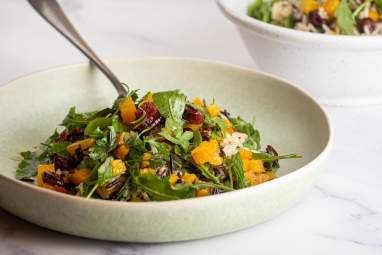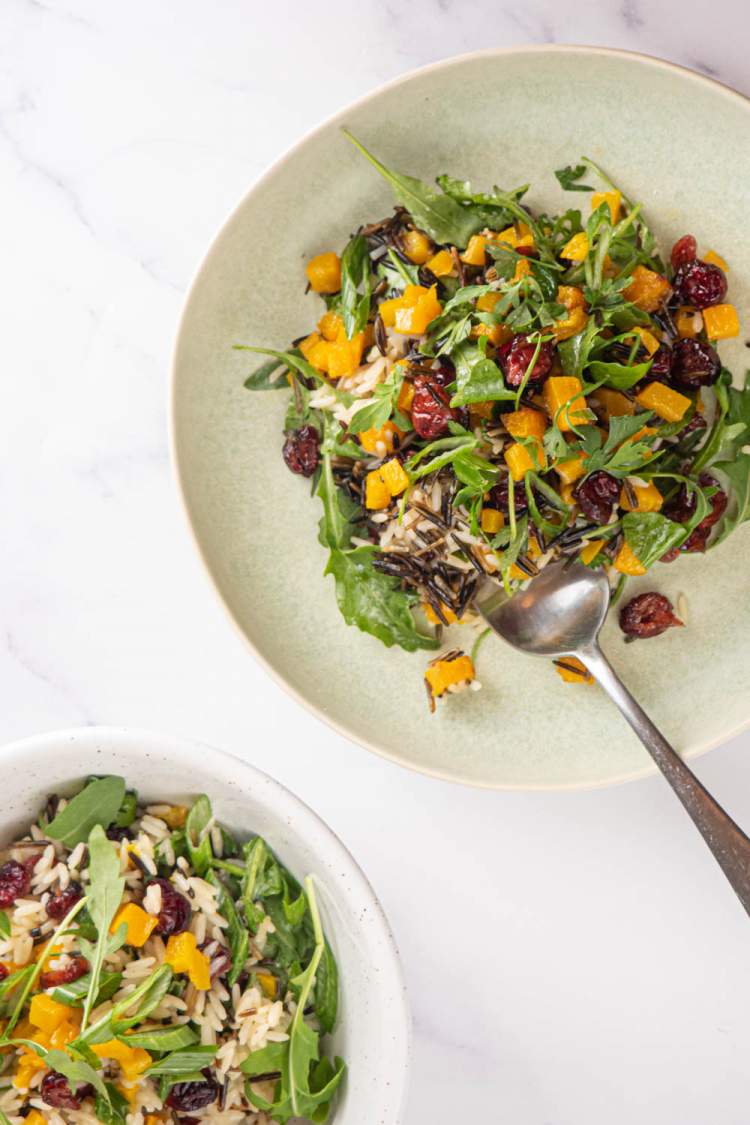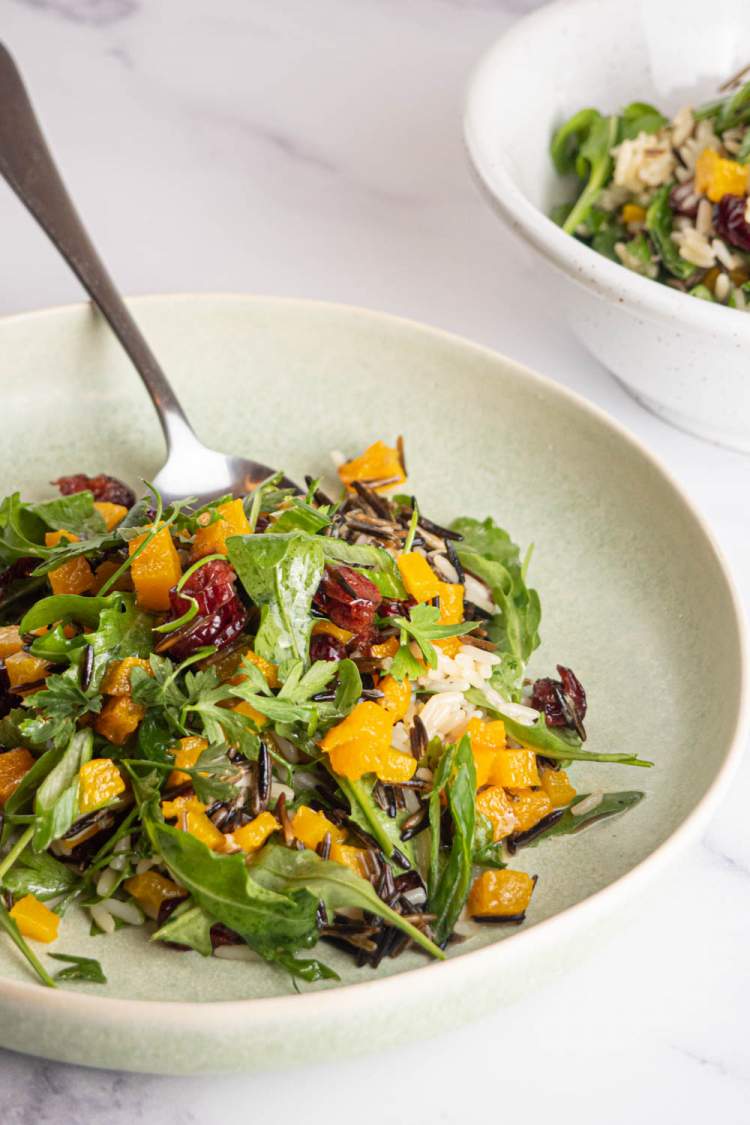Wild Rice Salad with acorn squash, cranberries, fresh arugula, and a delicious lemon tahini vinaigrette. This salad is packed with fall flavors and perfect for holiday meals.
Jump to Recipe keyboard_arrow_down
324 CALORIES
55g CARBS
10g FAT
8g PROTEIN
9
Freestyle™ SmartPoints™ New!
(9 Old SmartPoints™)
(9 PointsPlus®)

Wild Rice Salad with Acorn Squash Recipe
This Wild Rice Salad is exactly what I want to be eating in the fall. Made with nutty wild rice, roasted butternut squash, dried sweet cranberries, and an easy homemade lemon dressing. Serve it as an entree or alongside some Brown Sugar Chicken or Maple Pork Tenderloin.
Remember when wild rice was first a big deal? Was it the mid-90s maybe? It was the quinoa of the 90s. (Let’s just go with that.) It was nutritious, filling, had a great texture and was frou-frou enough to satisfy the granola type and be something fancy for the regular household cook to serve to guests as well as to introduce the family to something new and interesting.
And, as you all know, what comes around eventually goes away and then back around eventually. Like ripped jeans and those Steve Madden slides. And now wild rice. As you all do too I’m sure, I just instinctively reach for brown rice when I want rice and I forget about how delicious, nutty, and nutritious wild rice can be.
So, on a whim, for no reason other than I saw it in the grocery store and this time decided to purchase it instead of walking by, here I am cooking with it again — and loving it!
This salad celebrates wild rice and combines it with the flavors of fall including roasted squash, cranberries, and maple syrup. I had some acorn squash on hand so that’s what I used for this recipe but you could use butternut squash or any hearty squash you like.

Ideas for Customizing Wild Rice Salad with Acorn Squash
Here are some of my favorite ways to customize this wild rice recipe:
- If you’re not a super fan of wild rice, you can try half a cup of wild rice and half a cup of white or brown rice. (Follow package directions for both.)
- Use a different kind of squash, like butternut, cousa, or buttercup.
- Skip the squash and instead roast zucchini, yellow squash, eggplant, bell peppers, or another sort of hearty veggies that you do enjoy.
- Try potatoes for roasting — with or without the squash. Great options include russet, yellow gold, red, or sweet potatoes.
- Instead of craisins, try adding raisins.
- Use spinach, baby spring mix, kale, or even shaved Brussels sprouts instead of (or with) the arugula.
- If you don’t like the taste of maple, then you can use honey or agave.
- Don’t have time to make dressing? Use one you already have. Red wine vinegar or other vinegar-based dressing will go splendidly.
- You can use dried or fresh parsley, depending on what you have. Remember, dried is stronger than fresh.
- Feel free to use almond butter or miso in place of the tahini or leave it out altogether.

What makes this Wild Rice Salad healthy?
- Wild rice is a low-calorie, nutrient-dense grain that also happens to be a great plant source of protein. Containing manganese, protein, zinc, phosphorus, and magnesium, among other impressive nutrients, wild rice is also a great source of fiber. In addition, wild rice is a great grain to eat if you are gluten-free or seeking an excellent source of antioxidants.
- Olive oil is a great source of healthy fat, omega-6 and omega-3 fatty acids and is also contains tons of antioxidants, which are important for your body to help reduce the risk of chronic diseases. Olive oil is also great for fighting inflammation and protects against heart disease and stroke.
- Acorn squash is a surprisingly good source of vitamins C, B6, and A, niacin, folate, and thiamine. Acorn squash is also high in fiber and antioxidants. Plus, it will fill you up without a lot of calories and fat.
- All kinds of healthy fats are found in tahini which are great for your heart and cardiovascular system in general (in the right amounts). While not super low in calories, a little tahini goes a long way. It also contains a good amount of protein, some fiber, and is low in carbs and high in thiamine, vitamin B6, manganese, and phosphorus.
- Dijon mustard and mustard seeds, in general, are great sources of selenium and magnesium. These minerals are important for the prevention of cancer, and can help alleviate arthritis, high blood pressure, migraines, asthma, and more.
- Lemon juice is a great source of vitamin C, which, in turn, can help your skin look better and prevent kidney stones. Vitamin C is also good as a digestive aid and can help boost your immune system. Lemon juice is also known to be a digestive aid and breath freshener.
- Maple syrup is a great natural sweetener and is high in antioxidants, zinc, magnesium, potassium, calcium, and riboflavin.
- Arugula is a great green that is packed full of fiber and other nutrients. It barely has any sugar (or calories, carbs, or fat for that matter), and is high in potassium, calcium, folate, and vitamins C, A, and K.
- Green onions are a low-calorie and low-fat way to get in extra fiber, vitamins A, C, and K as well as healthy carbs, and antioxidants.
- Dried cranberries are just as good for you as fresh cranberries (provided they don’t have extra sugar added to them). They contain fiber, antioxidants, and vitamins A and C.
- Parsley is a great source of antioxidants, contains cancer-fighting vitamins and minerals, is good for your heart, and has antibacterial properties.
Source link